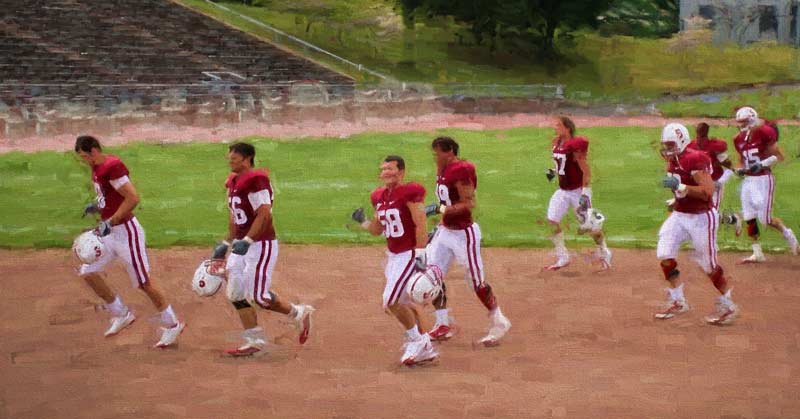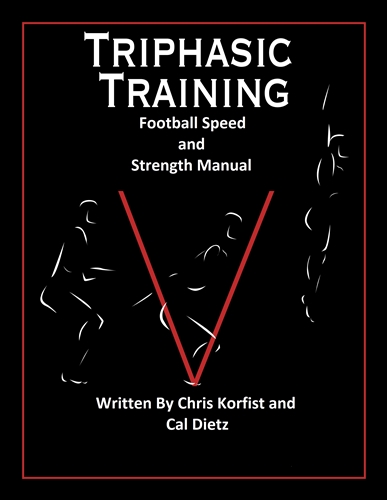
Earlier this year, I was given the opportunity to work with a football team, something that I haven’t done in over a decade. It was time to “put my money where my mouth is.” Coaching a football team is a much different task than coaching a track team, which I am still doing at a different school. Running an “off-season” football program makes my job more difficult because I have other issues to deal with, like athletes who are currently playing other sports and dabbling with what we are doing, athletes who just don’t show very often or even the athlete who continues to do what they want. And, I have to make the variety of people who participate happy. I need the gym rat and bench press champion to buy in as well as coaches who argue that the vertical jump and 40-yard dash are worthless tools to assess football. They argue, “We need to be power cleaning!” And in the next sentence say that moving the bar fast has no application to getting stronger. Luckily, only one person writes the check, and that is the one that I needed to make happy. His goal was singular, speed. Here is what we got.
My football group starts at 5:50 AM and goes until 7:10. We start the morning with group breathing in a power stance and go to activation. Our morning warmup either consists of the Cal Dietz warmup or classic GPP for 6 minutes. We are a signal based offense, so the coach signals to the players what exercise he wants, and the players have to react. The coach’s goal is to get a play off every 12 seconds, so that is our length per exercise. We look for immediate changes in the exercise.
From there we break into three groups. Our lifting is Cal Dietz’s Triphasic training with some minor changes to incorporate into the workout. One of the big changes is that I need to do weight room stuff because it is football and not to lift for football would be sacrilegious. But we get two days of running in. One is a fly 10 using our Freelap system, and the other is a start day. Originally I had hoped to do block times but ended up spending all of my time working on starting technique. This setup was convenient because the indoor track is connected to the weight room, and we can easily make the transition from the weight room to the track.
Once we shifted to the spring, we could focus more on football. Spring sports moved outside, and that gave us free reign of the field house, save the day of health fair where the PE department needed the weight room for a hospitality room and AP exams taking the 4th court. Our warm-up became agility work, where we worked squares, circles and T’s. Our weight room work shifted to phase 2 of the triphasic workout that consists of lighter loads and focusing on bar speed. And sprinting shifted to working on a 40. We broke the 40 into different segments and timed them with our Freelap. We started with a couple of weeks of fly and block 10yds but gradually spread out so the distance would be 40yds over the next four weeks. So a fly 20 and block 20 could be used for an athlete to add their times and figure what their perfect 40 would be.
Our “bumps” were, of course, Chicago weather. School can get canceled for snow or cold, weather is so bad that athletes don’t show, or spring sports move inside and have priority over out of season clubs (per our state rules). Additionally, we have athletes that have spotty attendance. We have athletes who do too much and in addition to their training will do multiple workouts with 7 on 7 passing clubs. This is not to mention the athletes who also are playing another sport while trying to train. Or, we have athletes that selectively train and pick what they want to do, like skip running and just sit in the weight room. The ones that kill my numbers are the ones who just didn’t feel like testing, so I get a goose egg for my numbers. I love the law of averages.
Some observations that I can make from the results are as followed:
- The athletes who refused to sprint or work on starts did not improve in their fly times. They did get stronger in the weight room, but fly times did not improve, and 40 times decreased. In some cases, we had athletes that ran a fly 10 as much as 0.10 seconds slower and also had a slower 40 by as much as well.
- Our track team prides itself on squatting heavy three days a week and does traditional long to short workout. The athletes that we shared had a drastic decrease in performance in the Vertical jump, fly 10 and 40-yard dash, meaning they just got slower and didn’t jump as high. We had some athletes in that group who couldn’t do a final test due to injury.
- Strangely enough, the athletes that ran their fly 10’s weekly and worked their starts in addition to their lifting had the greatest improvements. In some cases, we had improvements by as much as 0.2 in their fly 10 and a drop in time by .48 in their 40. Our best VJ performance was 5.3 inches from the first training block.
- I could not use pro agility times because they were not electronically timed. Different people hand-timed them but by doing daily agility drills, the athletes improved greatly.
On the whole, when factoring the good and the bad, we had some substantial improvements for the 90 athletes that we have show up. From the first block of 8 weeks, the average vertical improvement was 2.35 inches. The average improvement for the fly 10 was 0.12. When it is all said and done, we had some good team improvements. Again, everything was electronically timed, Just Jump pad and Freelap. As a team, our 40’s improved by an average of .314. Our vertical jump improved by 3.35 inches and our bench press average improvement was 28.8 lbs.
The test results can be downloaded here.
When I shared the results with Cal Dietz, strength coach of University of Minnesota and owner of XLAthlete.com, he was impressed. We decided to collaborate and put together a manual that coach or players can use and hopefully replicate the same results. This is a rare example of a manual that works on what football teams need to win, speed. The website for the manual is here.
Please share so others may benefit.
[mashshare]


